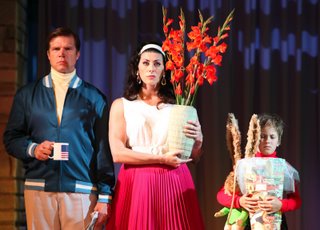Letter from Munich: Trouble in Tahiti
 Photo: Wilfrid Hosl
Photo: Wilfrid HoslThis rare Bernstein piece has always been problematic in the theatre. Its short 50-minute length means it isn’t quite sufficient for an evening’s entertainment. Like a few other Bernstein’s pieces, it is considered too lightweight by opera house when there are so many other, more “serious” Bernstein creations to choose from. European houses for some reason have always had greater appreciation for works the likes of West Side Story and Candide – I recall a staging of the former at the venerable La Scala. Set in suburban America in the 1950s, Trouble in Tahiti is a true period piece. My first encounter with it was a student production as an undergraduate more years ago can I care to recall. I never saw it again until two months ago when the Canadian Opera Company Ensemble Studio did a concert, albeit rather enjoyable, version at the Richard Bradshaw Amphitheatre. By a strange coincidence, I saw it again here in Munich, this time in a big budget, elaborate production starring Rodney Gilfry and Beth Clayton. Additional material in a sort of German cabaret style was composed for the occasion, expanding the show to approximately one hour fifteen minutes, so technically this version qualifies as a world premiere. It is part of “Under Construction”, a part of the 2009 Munich Opera Festival that focuses on the new and the experimental, thus the addition of new material.
It opened on July 7th – to a torrential downpour outside – at the Cuvillies-Theater, a stone’s throw from the National-Theater where incidentally a performance of Werther was in progress. The heavily gilded Rococo Cuvillies-Theater and Bernstein’s jazzy score make for strange bedfellows, yet on a certain level it works given the eclectic and deconstructionist aesthetic that have dominated European opera productions in recent decades. Apparently no expenses were spared in this production, with lots of extra material added on, including elaborate filmed sequences of the characters, presumably shot on location in suburban New York. Before a note of Bernstein’s score, a character made up to look like a latter-day Pierrot does a little skit in German of material composed for the occasion. In the background we see filmed footages of the daily lives of Dinah (Clayton) and Sam (Gilfry), the middle-class American couple. The scrim goes up to reveal a very well executed replica of the American home, down to the angel stone on the fireplace. The style is tongue-in-cheek irony. The yellow Happy Face takes pride of place over the fireplace, never mind that this ubiquitous icon of pop culture had not yet been invented in 1952 when Bernstein wrote the piece! It’s soon clear that all is not well – despite the exterior façade, the marriage is falling apart. Throughout, a jazz trio, not unlike the typical commedia dell’arte troupe, periodically interject to do a song and dance, giving us a running commentary. Each character ruminates about life, the wishes and dreams unfulfilled. There is really no resolution at the end, with Sam and Dinah agreeing to go see the latest movie in town, something called Trouble in Tahiti. Will they manage to reconcile? It’s left up to the audience. This ambiguous unresolved ending was an inspired stroke by Bernstein, as it was composed at a time (1952) when audiences still wanted, indeed expected, some sort of resolution, if not happy endings. It was unusual at the time, but despite all that was lavished on this piece in this production, it still comes across as awfully dated. I daresay if Bernstein were alive today, he would have composed something probably very different, maybe more along the lines of the recent film, Revolutionary Road. Clayton and Gilfry were visually perfect as the ideal American couple, and each gave a strong vocal performance. Her big number, ‘A Quiet Place’, was delivered with just the right mix of wistfulness and panache. The much-reduced Mahler Chamber Orchestra under Ken Nagano played well if a tad too loudly. A few of the set design and directorial touches by Schorsch Kamerun bordered on overkill, such as the giant inflated, Ken and Barbie-like dolls, or junior’s dinosaur. Even the lovely chandeliers in the theatre were called into service, flashing on and off during a particularly spirited jazz number! At the end of the day, it seems to me that Trouble in Tahiti is a frothy yet astute commentary on American culture, marriage and family life, no more and no less. This production, while fun to watch and very nicely performed, does appear to be rather inflated, even a little heavy-handed. Still, it’s not a bad way to spend 80 minutes in this incredibly beautiful theatre.




1 Comments:
In 2002, the Colorado Symphony Orchestra opened with "Trouble in Tahiti" and completed the evening with his "Chichester Psalms." I found it to be a terrific combo and extremely well performed.
By Paul, At
July 16, 2009 6:04 PM
Paul, At
July 16, 2009 6:04 PM
Post a Comment
<$I18N$LinksToThisPost>:
Create a Link
<< Home